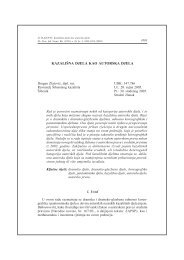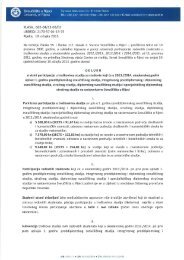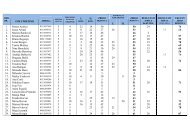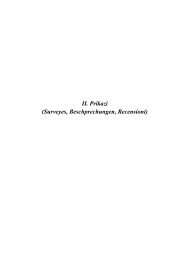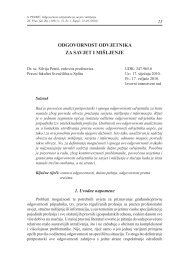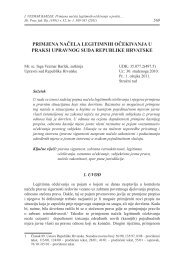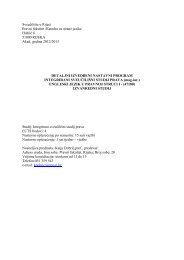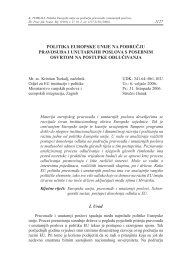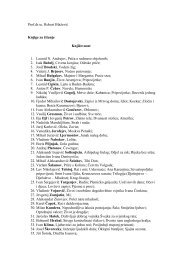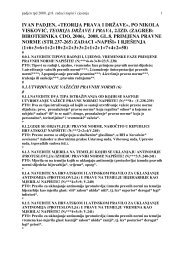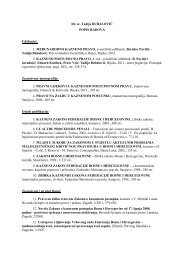HOUSE OF LORDS McLOUGHLIN v O'BRIAN [1982] 2 All ER 298 ...
HOUSE OF LORDS McLOUGHLIN v O'BRIAN [1982] 2 All ER 298 ...
HOUSE OF LORDS McLOUGHLIN v O'BRIAN [1982] 2 All ER 298 ...
You also want an ePaper? Increase the reach of your titles
YUMPU automatically turns print PDFs into web optimized ePapers that Google loves.
Benson v. Lee)? I think that unless the law is to draw an arbitrary line at the pointof direct sight and sound, these arguments require acceptance of the extensionmentioned above under 4 in the interests of justice.If one continues to follow the process of logical progression, it is hard to see whythe present plaintiff also should not succeed. She was not present at the accident,but she came very soon after upon its aftermath. If, from a distance of some 100yards (cf. Benson v. Lee), she had found her family by the roadside, she wouldhave come within principle 4 above. Can it make any difference that she comesupon them in an ambulance. or, as here, in a nearby hospital, when, as the evidenceshows, they were in the same condition, covered with oil and mud, and distraughtwith pain? If Mr. Chadwick can recover when, acting in accordance with normaland irresistible human instinct, and indeed moral compulsion, he goes to the sceneof an accident, may not a mother recover if, acting under the same motives, shegoes to where her family can be found?I could agree that a line can be drawn above her case with less hardship than wouldhave been apparent in Boardman v. Sanderson [1964] 1 W.L.R. 1317 and Hinz v.Berry [1970] 2 Q.B.40, but so to draw it would not appeal to most people’s senseof justice. To allow her claim may be, I think it is, upon the margin of what theprocess of logical progression would allow. But where the facts are strong andexceptional, and, as I think, fairly analogous, her case ought, prima facie, to beassimilated to those which have passed the test.To argue from one factual situation to another and to decide by analogy is a naturaltendency of the human and the legal mind. But the lawyer still has to inquirewhether, in so doing, he has crossed some critical line behind which he ought tostop. That is said to be the present case. The reasoning by which the Lords Justicesdecided not to grant relief to the plaintiff is instructive. Both Stephenson L.J. andGriffiths L.J. accepted that the ‘shock ‘ to the plaintiff was foreseeable; but fromthis, at least in presentation, they diverge. Stephenson L.J. considered that thedefendants owed a duty of care to the plaintiff, but that for reasons of policy thelaw should stop short of giving her damages: it should limit relief to those on ornear the highway at or near the time of the accident caused by the defendants’negligence. He was influenced by the fact that the courts of this country, and ofother common law jurisdictions, had stopped at this point: it was indicated by the
arrier of commercial sense and practical convenience. Griffiths L.J. took the viewthat although the injury to the plaintiff was foreseeable, there was no duty of care.The duty of care of drivers of motor vehicles was, according to decided cases,limited to persons and owners of property on the road or near to it who might bedirectly affected. The line should be drawn at this point. It was not even in theinterest of those suffering from shock as a class to extend the scope of thedefendants’ liability: to do so would quite likely delay their recovery by immersingthem in the anxiety of litigation.I am impressed by both of these arguments, which I have only briefly summarised.Though differing in expression, in the end, in my opinion, the two presentationsrest upon a common principle, namely that, at the margin, the boundaries of aman’s responsibility for acts of negligence have to be fixed as a matter of policy.Whatever is the correct jurisprudential analysis, it does not make any essentialdifference whether one says, with Stephenson L.J., that there is a duty but, as amatter of policy, the consequences of breach of it ought to be limited at a certainpoint, or whether, with Griffiths L.J., one says that the fact that consequences maybe foreseeable does not automatically impose a duty of care, does not do so in factwhere policy indicates the contrary. This is an approach which one can see veryclearly from the way in which Lord Atkin stated the neighbour principle inDonoghue v. Stevenson [1932] A.C. 562, 580: ‘persons who are so closely anddirectly affected by my act that I ought reasonably to have them in contemplationas being so affected. ... ‘ This is saying that foreseeability must be accompaniedand limited by the law’s judgment as to persons who ought, according to itsstandards of value or justice, to have been in contemplation. Foreseeability, whichinvolves a hypothetical person, looking with hindsight at an event which hasoccurred, is a formula adopted by English law, not merely for defining, but also forlimiting, the persons to whom duty may be owed, and the consequences for whichan actor may be held responsible. It is not merely an issue of fact to be left to befound as such. When it is said to result in a duty of care being owed to a person ora class, the statement that there is a ‘duty of care ‘ denotes a conclusion into theforming of which considerations of policy have entered. That foreseeability doesnot of itself, and automatically, lead to a duty of care is, I think, clear. I gave someexamples in Anns v. Merton London Borough Council [1978] A.C. 728, 752, Annsitself being one. I may add what Lord Reid said in McKew v. Holland & Hannen& Cubitts (Scotland) Ltd. [1969] 3 <strong>All</strong> E.R. 1621, 1623:
‘A defender is not liable for a consequence of a kind which is not foreseeable. Butit does not follow that he is liable for every consequence which a reasonable mancould foresee.’We must then consider the policy arguments. In doing so we must bear in mindthat cases of ‘nervous shock,’ and the possibility of claiming damages for it, arenot necessarily confined to those arising out of accidents on public roads. To state,therefore, a rule that recoverable damages must be confined to persons on or nearthe highway is to state not a principle in itself, but only an example of a moregeneral rule that recoverable damages must be confined to those within sight andsound of an event caused by negligence or, at least, to those in close, or very close,proximity to such a situation.The policy arguments against a wider extension can be stated under four heads.First, il may be said that such extension may lead to a proliferation of claims, andpossibly fraudulent claims, to the establishment of an industry of lawyers andpsychiatrists who will formulate a claim for nervous shock damages, includingwhat in America is called the customary miscarriage, for all, or many, roadaccidents and industrial accidents.Secondly, it may be claimed that an extension of liability would be unfair todefendants, as imposing damages out of proportion to the negligent conductcomplained of. In so far as such defendants are insured, a large additional burdenwill be placed on insurers, and ultimately upon the class of persons insured - roadusers or employers.Thirdly, to extend liability beyond the most direct and plain cases would greatlyincrease evidentiary difficulties and tend to lengthen litigation.Fourthly, it may be said - and the Court of Appeal agreed with this - that anextension of the scope of liability ought only to be made by the legislature, aftercareful research. This is the course which has been taken in New South Wales andthe Australian Capital Territory.
The whole argument has been well summed up by Dean Prosser (Prosser, Torts,4th ed. (1971), p. 256):‘The reluctance of the courts to enter this field even where the mental injury isclearly foreseeable, and the frequent mention of the difficulties of proof, thefacility of fraud, and the problem of finding a place to stop and draw the line,suggest that here it is the nature of the interest invaded and the type of damagewhich is the real obstacle.’Since he wrote, the type of damage has, in this country at least, become morefamiliar and less deterrent to recovery. and some of the arguments are susceptibleof answer. Fraudulent claims can be contained by the courts, who, also, can copewith evidentiary difficulties. The scarcity of cases which have occurred in the past,and the modest sums recovered, give some indication that fears of a flood oflitigation may be exaggerated - experience in other fields suggests that such fearsusually are. If some increase does occur, that may only reveal the existence of agenuine social need: that legislation has been found necessary in Australia mayindicate the same thing.But, these discounts accepted, there remains, in my opinion, just because ‘shock’in its nature is capable of affecting so wide a range of people, a real need for thelaw to place some limitation upon the extent of admissible claims. It is necessary toconsider three elements inherent in any claim: the class of persons whose claimsshould be recognised; the proximity of such persons to the accident; and the meansby which the shock is caused. As regards the class of persons, the possible range isbetween the closest of family ties - of parent and child, or husband and wife - andthe ordinary bystander. Existing law recognises the claims of the first: it denies thatof the second, either on the basis that such persons must be assumed to bepossessed of fortitude sufficient to enable them to endure the calamities of modernlife, or that defendants cannot be expected to compensate the world at large. In myopinion, these positions are justifiable, and since the present case falls within thefirst class, it is strictly unnecessary to say more. I think, however, that it shouldfollow that other cases involving less close relationships must be very carefullyscrutinised. I cannot say that they should never be admitted. The closer the tie (notmerely in relationship, but in care) the greater the claim for consideration. Theclaim, in any case, has to be judged in the light of the other factors, such as
proximity to the scene in time and place, and the nature of the accident.As regards proximity to the accident, it is obvious that this must be close in bothtime and space. It is, after all, the fact and consequence of the defendant’snegligence that must be proved to have caused the ‘nervous shock. ‘ Experiencehas shown that to insist on direct and immediate sight or hearing would beimpractical and unjust and that under what may be called the ‘aftermath’ doctrineone who, from close proximity, comes very soon upon the scene should not beexcluded. In my opinion, the result in Benson v. Lee [1972] V.R. 879 was correctand indeed inescapable. It was based, soundly, upon ‘direct perception of some ofthe events which go to make up the accident as an entire event, and this includes ...the immediate aftermath ... ‘ (p. 880.)The High Court’s majority decision in Chester v. Waverley Corporation (1939) 62C.L.R. 1, where a child’s body was found floating in a trench after a prolongedsearch, may perhaps be placed on the other side of a recognisable line (Evatt J. in apowerful dissent placed it on the same side), but, in addition, I find the conclusionof Lush J. to reflect developments in the law.Finally, and by way of reinforcement of ‘aftermath’ cases, I would accept, byanalogy with ‘rescue’ situations, that a person of whom it could be said that onecould expect nothing else than that he or she would come immediately to the scene- normally a parent or a spouse - could be regarded as being within the scope offoresight and duty. Where there is not immediate presence, account must be takenof the possibility of alterations in the circumstances, for which the defendantshould not be responsible.Subject only to these qualifications, I think that a strict test of proximity by sight orhearing should be applied by the courts.Lastly, as regards communication, there is no case in which the law hascompensated shock brought about by communication by a third party. InHambrook v. Stokes Brothers [1925] 1 K.B. 141, indeed, it was said that liabilitywould not arise in such a case and this is surely right. It was so decided inAbramzik v. Brenner (1967) 65 D.L.R. (2d) 651. The shock must come throughsight or hearing of the event or of its immediate aftermath. Whether some
equivalent of sight or hearing, e.g. through simultaneous television, would sufficemay have to be considered.My Lords, I believe that these indications, imperfectly sketched, and certainly to beapplied with common sense to individual situations in their entirety, representeither the existing law, or the existing law with only such circumstantial extensionas the common law process may legitimately make. They do not introduce a newprinciple. Nor do I see any reason why the law should retreat behind the linesalready drawn. I find on this appeal that the appellant’s case falls within theboundaries of the law so drawn. I would allow her appeal.


![HOUSE OF LORDS McLOUGHLIN v O'BRIAN [1982] 2 All ER 298 ...](https://img.yumpu.com/47692678/1/500x640/house-of-lords-mcloughlin-v-obrian-1982-2-all-er-298-.jpg)
